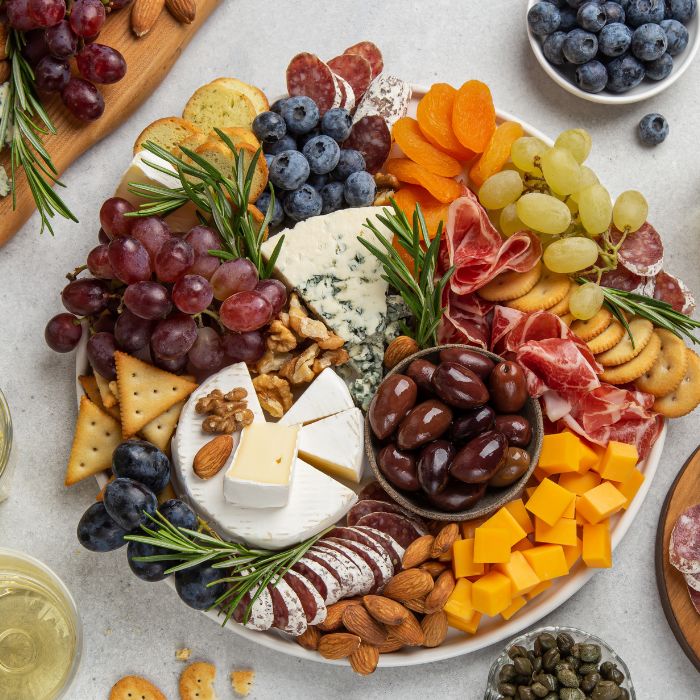The charcuterie board is more than an appetizer; it’s a creative journey. It combines local cheeses, hard sausages, mustard, and honey into an edible art form. This guide explores how to assemble an impressive charcuterie board. The twist? Participants learn to craft meat and cheese roses. This activity boosts teamwork and creativity.
Charcuterie Board History
The charcuterie board, with its artful arrangement of meats, cheeses, and accompaniments, has a rich history that spans centuries and cultures. This delightful culinary tradition originated in France, with “charcuterie” itself derived from the French words for flesh (“chair”) and cooked (“cuit”). Originally, charcuterie referred specifically to the products made and sold by charcutiers, primarily pork products such as sausages, hams, and pâtés. Over time, the concept evolved to encompass a broader range of prepared meat products.
In the 15th century, charcuterie was recognized as a distinct culinary craft in France, governed by strict regulations to ensure the quality and safety of the products. Charcutiers were not only artisans but also innovators, developing preservation methods that are still in use today, including salting, brining, and smoking. These techniques allowed meats to be stored for longer periods, making charcuterie an essential part of the French diet, especially in regions without easy access to fresh meat.
As charcuterie spread beyond France, it began to take on new forms and incorporate a wider variety of ingredients. In Italy, for example, charcuterie transformed into antipasto, with the inclusion of cheeses, olives, and vegetables. Similarly, other countries developed their own versions, adapting the concept to fit local tastes and available ingredients.
The modern charcuterie board, as we know it today, is a celebration of this rich history. It’s a canvas for culinary creativity, allowing for the combination of flavors, textures, and colors in a way that is both aesthetically pleasing and delicious. More than just a way to showcase cured meats and artisanal cheeses, charcuterie boards have become a social focal point, perfect for gatherings where food is shared and enjoyed together.
Team Building with Charcuterie
Building a board together enhances team spirit. Participants mix flavors and designs, aiming for beauty and taste. They learn to pair cheeses with meats and to craft salami roses. Such tasks mirror teamwork in the office, demanding communication and shared decisions.
In-Person Charcuterie Board and Wine
A charcuterie board presents an exceptional option for in-person gatherings, especially when paired with the right selection of wines. This pairing elevates the social experience, allowing guests to explore the nuanced interplay between the flavors of the board and the accompanying wines. Each sip and bite becomes a topic of conversation, fostering a shared culinary adventure among friends or colleagues. The act of sharing a charcuterie board and wine not only facilitates socialization but also creates a warm, inviting atmosphere. It encourages guests to gather around, share stories, and enjoy each other’s company in a relaxed setting. This communal dining experience, rich in variety and flavor, becomes a memorable occasion that celebrates the joy of good food, fine wine, and great company.
Making Meat and Cheese Roses
- Choose Your Ingredients: Pick soft cheeses and thin meat slices.
- Create Roses: Roll a salami slice to form a rose center. Wrap more slices around it for petals.
- Craft Cheese Roses: Use soft cheese strips. Roll them into buds and mix them with meat roses.
A Guide to Cheese Varieties on Your Charcuterie Board
An essential element of any charcuterie board is its selection of cheeses, each with its unique characteristics. Understanding these distinctions is crucial for assembling a board that invites curiosity and delight.
- Soft Cheeses: For instance, Brie and Camembert fall under this category. These cheeses are not only creamy and spreadable but also often embody a mild flavor. Such a profile complements the robust tastes of stronger meats beautifully.
- Semi-Soft Cheeses: On the other hand, varieties like Havarti and Munster provide a slightly firmer texture. Nevertheless, they still offer a delightful melt-in-your-mouth experience. These cheeses are incredibly versatile, pairing equally well with both sweet jams and savory nuts.
- Hard Cheeses: Moreover, we have hard cheeses, such as Parmesan and aged Cheddar. These selections are known for their density and crumbly nature, along with rich flavors that become more pronounced with age. A slice of hard cheese adds a welcomed depth of taste, contrasting nicely with other board elements.
- Blue Cheeses: Lastly, blue cheeses, recognizable by their distinctive veins of blue mold, such as Gorgonzola and Roquefort, stand out for their bold and tangy profiles. They introduce an intense flavor that can elevate the entire charcuterie experience.
By selecting a variety of cheeses, you ensure that every nibble offers a discovery, encouraging exploration and conversation among team members. Furthermore, the differences in cheese types—from the creamy delicacy of Brie to the sharp tang of blue cheese—reflect the diverse talents and contributions each team member brings. Just as this diversity enriches the board’s flavors, it similarly enhances the team’s overall dynamics, contributing to a more harmonious and effective collaboration.
Creative Freedom
Creating a charcuterie board allows endless creativity. Teams can decide on themes, colors, and textures. This process boosts morale and fosters unity. Each member’s input makes the final board a collective artwork.
 The Team Experience
The Team Experience
The creation of a charcuterie board, much like any culinary endeavor, can reveal a lot about a person’s personality. For instance, those with a more meticulous and detail-oriented nature might assemble their board with precision, aligning each slice of meat and cheese with care, and ensuring a harmonious balance of colors and textures. Their boards might also feature a variety of artisanal cheeses and rare meats, showcasing a deep appreciation for craftsmanship and quality. On the other hand, individuals who possess a more spontaneous and adventurous spirit might create a charcuterie board that’s eclectic and unexpected, mixing bold flavors and incorporating exotic ingredients to surprise and delight their guests. They’re likely to experiment with unusual pairings, like spicy meats with sweet jams, embracing the joy of discovery in each bite. Meanwhile, those who value tradition and comfort might lean towards classic combinations known for their timeless appeal, creating boards that offer a sense of warmth and familiarity. This approach to charcuterie board creation not only reflects individual tastes but also serves as an expression of one’s approach to life, whether it be careful planning, adventurous exploration, or a deep appreciation for the comforts of home.
For Dessert
A charcuterie board for team building enhances teamwork, communication, and creativity. It’s an enjoyable way for teams to bond. They work together, share ideas, and enjoy their creation. This experience shows how collaboration can lead to delicious results.


 The Team Experience
The Team Experience





